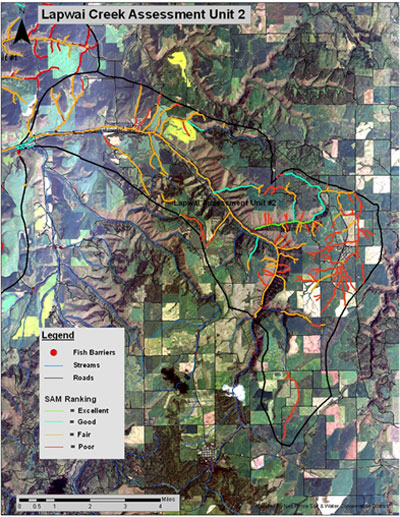Livestock grazing, particularly by cattle, has altered or eradicated native vegetation on much of the rangeland area previously grazed and browsed by wildlife (Platts, 1991), particularly within water-rich riparian areas. Erosion and soil compaction arise in areas where livestock are confined, affecting terrestrial and aquatic productivity and promoting weed infestations; increased fine sediment affects spawning and rearing habitat of salmonids and other fishes. The presence of cattle in riparian or streambed areas can lead to increased E. coli levels, which are of concern to aquatic systems and humans alike.
The results of such alterations to the watershed may include an increased delivery rate of runoff to streams, with increased sediment and nutrient loads. A higher rate of delivery changes the overall timing and duration of water returned to the stream. Rapid runoff may reduce the amount of available groundwater, which lowers the water table. The combination of altered inflow and altered groundwater may result in decreased summer baseflows (Carter, 2001).

Sedimentation
Sediment covers and fills instream substrate crucial to fish for food availability, cover, and spawning. Excessive sedimentation can result from watershed inputs (from upland grazing); instream trampling, disturbance and erosion due to banks denuded of vegetation; reduced sediment entrapment by riparian vegetation; reduced bank stability; and increased peak flows due to compaction.
Streamflow
Compaction and loss of ground cover due to grazing decreases infiltration, which leads to increased overland flow. This changes summer base flows; the timing and duration of recharge to streams; timing, duration and volume of peak flow events, and increases erosion and potential for flooding. Changes may be significant enough that perennial streams flow ephemerally and ephemeral streams dry up.
Temperature
The loss of riparian vegetation can lead to greatly increased stream temperature due to increased surface exposure to radiant heat. This increase, combined with increases due to widened stream channels, low summer flow and loss of undercut banks due to streamside grazing, can result in lethal temperatures for fish.
Nutrients
Reduced riparian vegetation and increased compaction can result in faster delivery of runoff to streams. Nutrients may not filter out as efficiently as in a properly functioning riparian area, resulting in increased nutrient loads from livestock urine and manure in and around the stream. Reduced summer flows can further concentrate nutrients.
Grazing occurs in the Lapwai Basin year-round. Typically, cattle graze in the canyons in spring, mountains in the summer and fall and are moved to feedlots during the winter. Within Nez Perce County, 41% of those feedlot operators allow access to streams while only 16% provide off-site watering opportunities (District, 1998). Impacts from these operations include accumulation of animal waste in a confined area, leaching of animal waste, stream-side degradation, and impaired water quality. According to the District’s Confined Animal Feeding Operation Inventory and Analysis (1998), Lapwai Creek is considered to be at high risk for water quality impairment. Sweetwater and Mission Creeks are considered to be at moderate risk, and Webb Creek is considered to be at low risk. Rotation schedules, grazing animals better-suited for the area (including sheep), development of off-site watering systems, and riparian area fencing, with the exclusion of agriculture waste systems, etc., are a few tools available to help dissipate the effects of grazing near salmonid streams.
Rolling plateaus of non-irrigated cropland with slopes of 3-25% typify the watershed’s upland areas; agricultural land comprises more than 60% of the watershed total surface area. Winter wheat is the top crop produced in the area, followed by spring barley and legumes. Most watershed agricultural producers use a three year crop rotation and apply an average of 100 lbs/acre of anhydrous nitrogen as fertilizer (NPSWCD, 1995). Overall, only 43% of those surveyed reported soil testing to determine their specific fertilizer requirements (District, 1995). The majority of those who performed soil tests did so on a three year sampling frequency (District, 1995). Because of the slopes, land uses and soil types, this area is susceptible to erosion-related failures in the lowlands, while the uplands are relatively stable. Culverts in agricultural areas such as these may have an increased likelihood of plugging, causing super-saturated soil conditions and culvert failures.
Treatment Action Recommendations for the Agricultural Uplands
- Riparian plantings consisting of forb, tree, and shrub components are recommended for all areas where adequate riparian zones do not exist.
- Conservation easements should be used where feasible.
- Vegetative buffers, including both filter strips and riparian plantings, are needed in cropland areas where tillage occurs adjacent to the stream channels.
- Wetland restoration and enhancement, including the removal of drain tiles and wetland plantings, is recommended where historic wetlands were once located in the uplands.
- Where livestock grazing occurs, improved grazing management, riparian fencing, and off-stream water developments should be employed.
- Dikes and berms that tend to limit floodplain access, potentially leading to channelization, incision, and straightening should be removed or modified. This may include off-set dikes, removal of fill material, relief culverts and other options as may be feasible.
- Road decommissioning should be considered where roads are located within the riparian area and are causing reduced riparian function. Road maintenance including the replacement of poorly placed and poorly sized culverts should be considered.
- Areas threatened by noxious and invasive weeds should be treated in accordance and cooperation with the Clearwater Basin Weed Management Area.